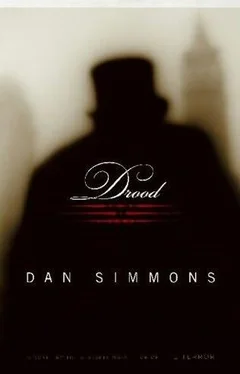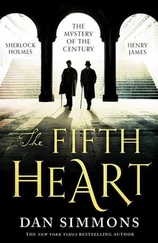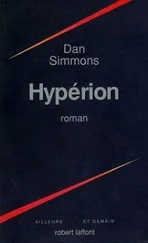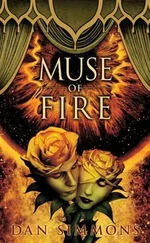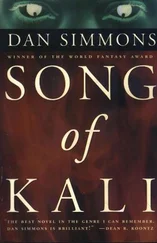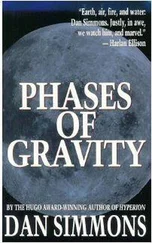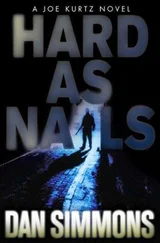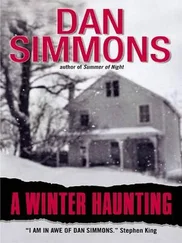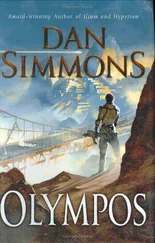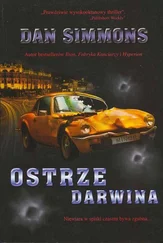“No,” I said. We were ten steps down with no end of the steep shaft in sight. The “steps” were more like pyramid blocks, at least three feet from one level down to the next, each step and slab slick with trickles of underground moisture, the shadows thrown by the small lantern ink black and deceptive, and if either of us stumbled here, it would certainly result in broken bones and most probably a broken neck. I half-stepped, half-jumped to the next step down, panting as I tried to keep up with the tiny cone of bobbing light emanating from Dickens’s hand. “A friend of yours, Charles?” I asked. “An expert on crypts and catacombs, perhaps?”
Dickens laughed. The echo was wonderfully awful in the steep stone shaft. I hoped with all my heart that he would not do it again.
“A definitive ‘no’ to your first question, my dear Wilkie,” he said. “Quite possibly a ‘yes’ to the second surmise.”
Dickens had stopped on a level area and now he turned the lantern to illuminate steep walls, a low ceiling ahead, and a corridor stretching off into the dark. Black rectangles on both sides of the corridor suggested open doorways. I jumped down onto the last step to join him. He turned to me and rested both hands and the bullseye on the brass beak of his stick.
“I met Poe in Baltimore during the last weeks of my 1842 tour in America,” he said. “I must say that the fellow forced first his book, Tales of the Grotesque and Arabesque, on me, and then his attention. Freely conversing as if we were equals or old friends, Poe kept us talking—or kept himself talking, I should say—for hours, about literature and his work and my work and again about his work. I never did get around to reading his stories while I was in America, but Catherine did. She was quite enthralled. Evidently this Poe loved to write about crypts, corpses, premature burials, and hearts ripped out of living breasts.”
I kept peering into the darkness beyond the tiny circle of light from the bullseye. Straining so hard—my eyes are not strong—made the shadows everywhere coalesce and shift, like tall forms stirring. My headache grew worse.
“I presume that all this has some relevance, Dickens,” I said sharply.
“Only in the sense that I am receiving the distinct impression that Mr Edgar Allan Poe would be enjoying this outing more than you are at the moment, my dear Wilkie.”
“Well then,” I said a bit sharply, “I wish your friend Poe were here now.”
Dickens laughed again, the echo not so intense this time but even more unnerving as it bounced off unseen walls and niches in the dark. “Perhaps he is. Perhaps he is. I remember reading that Mr Poe died only six or seven years after I met him, quite young and under odd and perhaps unseemly circumstances. From our brief but intense acquaintanceship, this place seems to be exactly the kind of stone barrow his ghost would enjoy haunting.”
“What is this place?” I asked.
As if in answer, Dickens raised the lantern and led the way down the corridor. The doorways I had sensed on both sides were actually open niches. Dickens aimed the bullseye into the first niche on our right as we reached it.
About six feet into this space, an elaborate iron grille rose from the stone floor to stone ceiling; the grille was massive, its cross-members solid, but had openings in the shape of florettes. The blood-red-and-orange iron looked so ancient and rusted that I felt that it would crumble away if I stepped in and struck it with my fist. But I had no intention of stepping into the niche. Behind the iron grille were rows and columns of stacked coffins so solid that I guessed them to be lined with lead. I counted about a dozen in the shifting light and shadows.
“Can you read that plate, Wilkie?”
Dickens was referring to a white stone plaque set high on the iron grille. Another plaque had fallen into the accumulated dirt and heaps of rust on the floor of the niche and a third was lying on its side at the base of the grille.
I adjusted my glasses and squinted. The stone was streaked and stained white by the rising damp and was pockmarked with dark red from the rusted grille beneath and around it. The letters appeared to be—
E. I.
THE CAYA[obscured]OMB
OF
[missing]HE REV[obscured]D
L.L. B [stain obscured]
I read this to Dickens, who had stepped inside for a closer look, and then I said, “Not Roman, then.”
“These catacombs?” said Dickens in his distracted manner as he crouched to try to read the plate that had fallen into the dirt like a tumbled headstone. “No. They were built in the essential Roman manner—deep corridors lined on both sides with burial niches—but original Roman catacombs would be labyrinthine in layout. These were Christian, but very old, Wilkie, very old, and therefore designed, as some of our city is above, on the grid. In this case, it is laid out as a central cross surrounded by these burial niches and smaller passages. You notice the arched brick rather than stone above me here…” He aimed the lantern higher.
I did notice the arched brick vault then. And for the first time I realised that the reddish “dirt” on the floor, several inches deep in places, was detritus from the crumbling bricks and mortar falling from that vaulted ceiling.
“This was a Christian catacombs,” repeated Dickens. “Installed directly under the chapel above.”
“But there is no chapel above,” I whispered.
“Not for many years,” agreed Dickens, rising and trying to flick the dirt from his gloves while still holding the lantern and his stick. “But there was long ago. A monastery chapel would be my guess. Part of the Monastery of the Church of Saint Ghastly Grim’s.”
“You made that up,” I said accusingly.
Dickens looked at me oddly. “Of course I did,” he said. “Shall we move on?”
I hadn’t liked standing in the dark corridor with no light behind me, so I was grateful when Dickens emerged from the niche and prepared to press on. But first he shone the light back into the vault again, passing its beam over the rows and columns of coffins stacked behind the rusting grille.
“I neglected to mention,” he said softly, “that as with their Roman originals, these burial niches are called loculi . Each loculus is reserved for a family or perhaps for members of a specific order of monks over many decades. The Romans tended to excavate their catacombs logically, all at one time, but these later Christian tunnels were dug out over a much longer period of time and tend to stray and wander. Do you know Garraway’s Coffee House?”
“On Exchange Alley?” I said. “Cornhill? But of course. I’ve had coffee there many a time while waiting for a sale to begin in the adjoining auction house.”
“There is a similar old monastery crypt under Garraway’s,” said Dickens, whispering now as if he were afraid some spectral form had joined us. “I have been in it, down there among the port wine. I have often wondered if Garraway’s is taking pity on the mouldy men who wait in its public-room all their lives by giving them that cool crypt down below to hold the rest of those gone missing from what fools call ‘real life’ up there on the surface.” He glanced at me. “Of course, my dear Wilkie, the catacombs of Paris—and you have been there, I know, since I took you there—the catacombs of Paris would not be large enough to hold the rest of the truly missing souls of London if we were all forced to go below, out of the light, down into the mouldy dark where we belong when we forget how to live well among upright men.”
“Dickens, what in the deuce are you going on about…” I stopped. There had been a stirring or footstep down the dark corridor, out of the weak glow of our single small lamp.
Читать дальше
